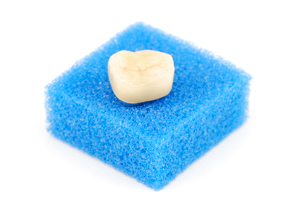Dental Crown FAQs
 What are crowns?
What are crowns?
A crown is a restoration that covers, or “caps,” a tooth to restore it to its normal shape and size, strengthening and improving the appearance of a tooth. Crowns are necessary when a tooth is generally broken down and fillings won’t solve the problem. If a tooth is cracked, a crown holds the tooth together to seal the cracks so the damage doesn’t get worse. Crown are also used to support a large filling when there isn’t enough of the tooth remaining, attach a bridge, protect weak teeth from fracturing, restore fractured teeth, or cover badly shaped or discolored teeth.
How is a crown placed?
To prepare the tooth for a crown, it is reduced so the crown can fit over it. An impression of teeth and gums is made and sent off to the lab for the crown fabrication. A temporary crown is fitted over the tooth until the permanent crown is made. On the next visit, the dentist removes the temporary crown and cements the permanent crown onto the tooth.
Will it look natural?
Yes. The main goal is to create a crown that look like a natural tooth. That is why we take impressions. To achieve a certain look, a number of factors are considered, such as the color, bite, shape, and length of your natural teeth. Any one of these factors alone can affect your appearance.
If you have a certain cosmetic look in mind for your crown, discuss it with us at your initial visit. When the procedure is complete, your teeth will not only be stronger, but they may be more attractive.
Why crowns and not veneers?
Crowns require more tooth structure removal, hence, they cover more of the tooth than veneers. Crowns are stationary and are customarily indicated for teeth that have sustained significant loss of structure, or to replace missing teeth. Crowns may be placed on natural teeth or dental implants.
How should I take care of my crowns?
To prevent damaging or fracturing the crowns, avoid chewing hard foods, ice or other hard objects. You also want to avoid teeth grinding. Besides visiting your dentist and brushing twice a day, cleaning between your teeth is vital with crowns. Floss or interdental cleaners (specially shaped brushes and sticks) are important tools to remove plaque from the crown area where the gum meets the tooth. Plaque in that area can cause dental decay and gum disease.
![]()
About Yuri Kaneda, DDS
Dr. Yuri Kaneda was born in Japan and immigrated to the US when she was 4 years old with her family. She lived in Ohio, Nebraska, and Illinois before finally settling in the San Diego area. A graduate of Bonita Vista High School, she went on to the University of California Berkeley where she obtained her Bachelors in Microbiology and Immunology. After working for 2 years in growth plate research at University of California San Diego, she went to the University of California San Francisco Dental School for her Doctor of Dental Surgery degree. Upon graduation, she returned to San Diego where she worked as an associate in the practice of Drs. Morimoto and Yaryan, her childhood dentist. She then started her own practice in 1995 and has been at her present location since 1999 which happens to be across the street from her high school!
View all posts by Yuri Kaneda, DDS →
Appointments
To schedule an appointment please email us at [email protected].

